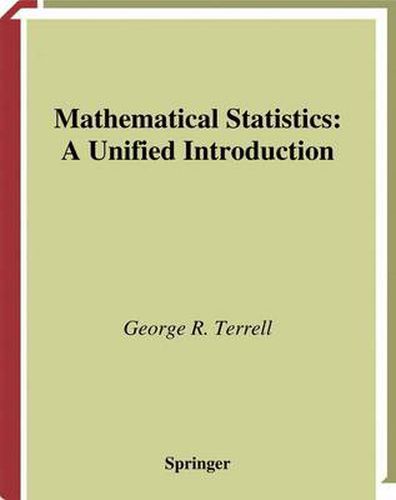Readings Newsletter
Become a Readings Member to make your shopping experience even easier.
Sign in or sign up for free!
You’re not far away from qualifying for FREE standard shipping within Australia
You’ve qualified for FREE standard shipping within Australia
The cart is loading…






This title is printed to order. This book may have been self-published. If so, we cannot guarantee the quality of the content. In the main most books will have gone through the editing process however some may not. We therefore suggest that you be aware of this before ordering this book. If in doubt check either the author or publisher’s details as we are unable to accept any returns unless they are faulty. Please contact us if you have any questions.
This textbook introduces the mathematical concepts and methods that underlie statistics. The course is unified, in the sense that no prior knowledge of probability theory is assumed; this is developed as needed. The book is committed to a high level of mathematical seriousness; and to an intimate connection with application. Modern methods, such as logistic regression, are introduced; as are unjustly neglected clasical topics, such as elementary asymptotics. The book first develops elementary linear models for measured data and multiplicative models for counted data. Simple probability models for random error follow. The most important famiies of random variables are then studied in detail, emphasizing their interrelationships and their large-sample behavior. Inference, including classical, Bayesian, finite population, and likelihood-based, is introduced as the necessary mathematical tools become available. In teaching style, the book aims to be * mathematically complete: every formula is derived, every theorem proved at the appropriate level * concrete: each new concept is introduced and exemplified by interesting statistical problems; and more abstract concepts appear only gradually * constructive: direct derivations and proofs are preferred * active: students are led to do mathematical statistics, not just to appreciate it, with the assistance of 500 interesting exercises. The text is aimed for the upper undergraduate level, or the beginning Masters program level. It assumes the usual two-year college mathematics sequence, including an introduction to multiple integrals, matrix algebra, and infinite series. George R. Terrell received his degrees from Rice University, where he later taught. Since 1986 he has taught in the Statistics Department of
$9.00 standard shipping within Australia
FREE standard shipping within Australia for orders over $100.00
Express & International shipping calculated at checkout
This title is printed to order. This book may have been self-published. If so, we cannot guarantee the quality of the content. In the main most books will have gone through the editing process however some may not. We therefore suggest that you be aware of this before ordering this book. If in doubt check either the author or publisher’s details as we are unable to accept any returns unless they are faulty. Please contact us if you have any questions.
This textbook introduces the mathematical concepts and methods that underlie statistics. The course is unified, in the sense that no prior knowledge of probability theory is assumed; this is developed as needed. The book is committed to a high level of mathematical seriousness; and to an intimate connection with application. Modern methods, such as logistic regression, are introduced; as are unjustly neglected clasical topics, such as elementary asymptotics. The book first develops elementary linear models for measured data and multiplicative models for counted data. Simple probability models for random error follow. The most important famiies of random variables are then studied in detail, emphasizing their interrelationships and their large-sample behavior. Inference, including classical, Bayesian, finite population, and likelihood-based, is introduced as the necessary mathematical tools become available. In teaching style, the book aims to be * mathematically complete: every formula is derived, every theorem proved at the appropriate level * concrete: each new concept is introduced and exemplified by interesting statistical problems; and more abstract concepts appear only gradually * constructive: direct derivations and proofs are preferred * active: students are led to do mathematical statistics, not just to appreciate it, with the assistance of 500 interesting exercises. The text is aimed for the upper undergraduate level, or the beginning Masters program level. It assumes the usual two-year college mathematics sequence, including an introduction to multiple integrals, matrix algebra, and infinite series. George R. Terrell received his degrees from Rice University, where he later taught. Since 1986 he has taught in the Statistics Department of